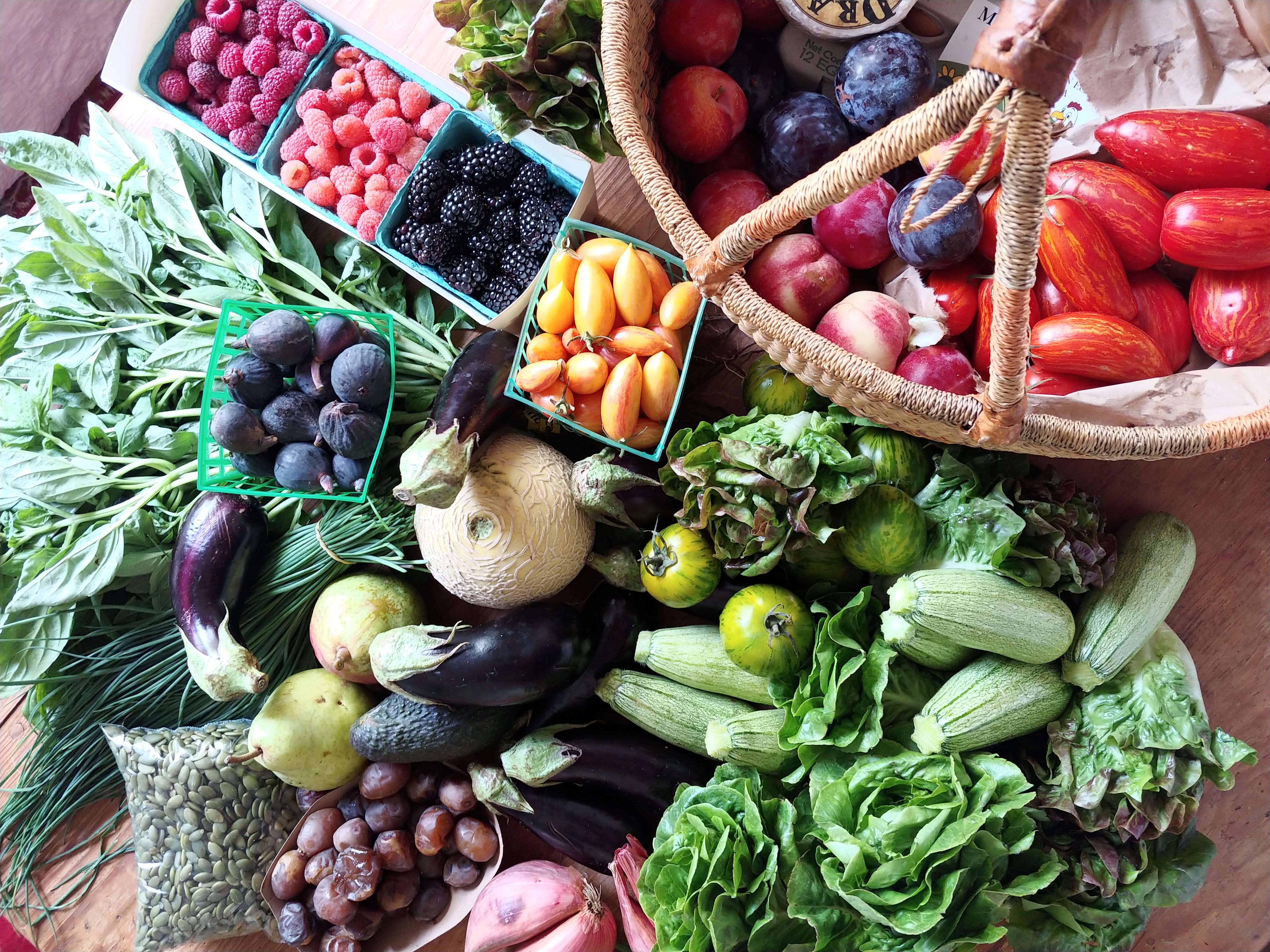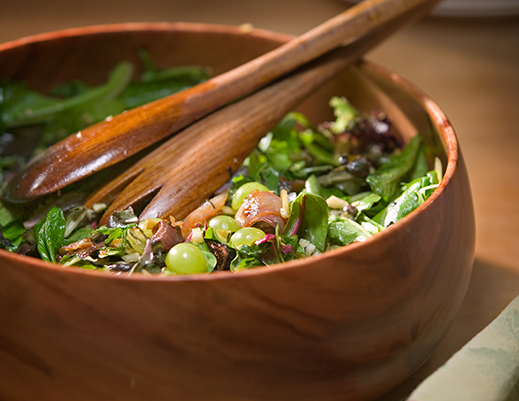
The French gourmet and politician turned gastronomical raconteur Anthalem Brillat-Savarin, recounts in his excellent treatise, The Physiology of Taste, the story of a young nobleman, The Chevalier d’Albignac, who, having escaped the ravages of the French Revolution, found himself in London and in need of earning a living.
One evening whilst dining with friends at an inn, he was approached by a gentlemen, who upon hearing that he was French, asked him if he could make for them a salad ‘in the French fashion’. Appreciative of the solicitous manner in which the request was made, the Chevalier obliged and created a salad that was greatly admired. So much so that he was asked to perform the same task the following week. There again he created a delicious salad. His reputation was quickly established and he spent the next few years traveling around the English capital in a private barouche with cabinets designed to carry his special condiments, including truffles, caviar, anchovies, scented oils and specialized vinegars.
There are some who credit this young entrepreneur with bringing this type of fresh green salad to England and indeed his creations became all the rage. However a century prior to this in 1799, John Evelyn published the first English-Language cookbook dedicated solely to salads - Acetaria: A Discourse on Sallets. He championed eating greens of all sorts, despite the seventeenth century English preference for grains and odiferous meats. He directed his readers to ‘dress their salads with oil of a pallid olive … such as native Lucca olives’ encouraged the use of the best available vinegar, suggested adding fine crystals of salt, and recommended mixing salad greens with mache, spinach, arrugula, endive, fennel, radish and nasturtiums. In short a salad that I would make for lunch today.
The current fashion for salads with a multitude of ingredients, a blending of savory and sweet, is not as we can see some hot new trend. Indeed, Mr. Evelyn’s work is pre-dated by millennia to the time of ancient Rome. In Columella’s epic work De Re Rustica, he describes a salad of fresh mint, cilantro, leeks and parsley, thyme, fresh cheese dressed with olive oil, vinegar, salt and pepper. What could be more apropos?
In the sixteen hundred years (or so) that have passed since the fall of Rome, culinary trends have ebbed and flowed, a mirror of their epoch. The influence of the church, both Roman Catholic and Eastern Orthodox, had profound effects on how, when and what food was consumed. The humble salad, however, seems to have escaped the dietary restrictions imposed by the various religious and political orders of the ages and weathered the centuries seemingly intact. Despite the fact that the English went through phases of distrusting raw vegetables, and according to William Harrison in his 1577 work on the fifteenth century dietary habits of his countrymen, who considered this ‘food as more meet for hogs and savage beasts to feed upon than mankind’, the salad that graced the table’s in Shakespeare’s time would not be out of place today. The bard’s plays are sprinkled with herbal references and gests on salads - ‘She was the sweet-marjoram of the sallat, or rather, the herb of grace’ or then again ‘pick a sallat another while, which is not amiss to cool a man’s stomach this hot weather’.
This second quote reflects a belief that holds true to this day (that salads are cooling) and influenced at what point in a meal salads were and are eaten. Since the time of Aristotle and Galen’s theory of the ‘four bodily humors’, all foods were attributed certain properties that affected a person’s health and digestion. They were to varying degrees hot or cold, moist or dry. Different foods had to be consumed in a particular order to open the appetite and aid digestion. Lighter foods, it was said, should be served first (hence the salad at the beginning of the meal) and heavier meats and dishes would follow. This practice is still followed in the United States.
The passage of time and modern eating habits have had an influence on just when we should serve a salad. There are those that argue that the vinegar in most salads will destroy the taste of any wine served with it and should therefore be served at the end of the meal. Others reason that the digestive effect of salad is more effective when served after the main course; a tradition adhered to in France. Whatever one’s preference, this dish has now evolved to the point that is has become a meal in and of itself.
With the notable exception of the horrors of molded Jello salads foisted upon the masses in the 1950’s - a wiggling mass of lime green, filled with suspended olives and tomatoes and decorated with mayonnaise – salads have thankfully emerged into the creative and delicious amalgams reflective of the 21st century. Now the new blend of cross-cultures draws dishes from around the world and influences everyday cooking.
Tabouleh, the Middle Eastern herb and bulgur salad is now ubiquitous, as is Salade Nicoise, the tuna, green bean, tomato and egg specialty from Nice. Asian and African spices have become readily available; Chermoula, Za’atar, Ras al Hanout, Curry Leaves, Kokum, Sichuan Pepper, Wasabi and Tamarind to name a few.
Our global market place has not only influenced what we put into these dishes but also what we grow. Our local farmer’s markets are now filled with Daikon, Mung Beans, Bok Choy, Chinese cabbage and more. Local farmers who immigrated from Laos, Vietnam and Cambodia have brought in vegetables native to their cultures and these in turn have become part of our new, seasonal culinary heritage. A trend that will continue to grow as the migration of people around the world continues.
It is refreshing to know that the fundamentals of salad making depend on a few simple things; excellent (preferably local) fresh ingredients and as Oscar Wilde once said ‘To make a good salad is to be a brilliant diplomat – the problem is entirely the same in both cases. To know how much oil one must put with one’s vinegar’. Evidently the Chevalier d’Albignac knew precisely what proportions to use for he returned to his native France, his fortune made from making salad with élan.

Serves 8 people
For the shallots:
8 whole shallots – peeled and cut in half
1 teaspoon butter
1 tablespoon olive oil
2 teaspoons sugar
Salt and pepper
For the salad:
¾ lb field greens – washed
1 fennel bulb – sliced and then cut into thin pieces
4 oz Roquefort cheese – crumbled
½ lb grapes – each grape cut in half if they are very big
For the vinaigrette:
¼ cup olive oil
2 tablespoons apple bouquet vinegar
1 teaspoon fig puree
A pinch of coarse salt
GRILLED DUCK, ENDIVES AND ARRUGULA SALAD
Serves 8 people
8 duck breasts – skin side scored lightly with a sharp knife
For the vinaigrette
Olive oil
3 tablespoons apple bouquet vinegar
2 teaspoons fig puree
3 or 4 twists of freshly ground black pepper
1 pinch coarse sea salt
½ lb arrugula
¼ lb mixed salad greens
1 tablespoon light brown sugar
1 tablespoon Butter
4 endives – sliced crosswise into thin strips
Chives – finely chopped
LATE SUMMER PEACH AND FETA SALAD
Serves 8 people
4 peaches – sliced
2 apples – cored and sliced
1 bunch radishes – cut into thin slices
8oz feta – cut into small pieces
1 bunch spring onions – thinly sliced
1 bunch chives – finely diced
Zest of 1 lemon
4 oz black olives – sliced
Lemon olive oil
A large pinch coarse sea salt
Coarsely ground black peppercorns
WILD SALMON SALAD
Serves 8 people
For the beets: [Note: these need to be prepared ahead of the salmon if you only have one oven.]
8 medium –large golden beets – peeled and cut into eighths
1 large red onion – thinly sliced
6 shallots – peeled and quartered
2 tablespoons olive oil
1 tablespoon sweet vinegar – such as a balsamic or apple cider
Coarse sea salt
Pepper
1 bunch chives – finely chopped
For the salmon:
2lbs wild salmon
½ cup shallots – finely diced
¼ cup dill – finely chopped
¼ cup parsley – finely chopped
Zest and juice of 1 lemon
1 tablespoon olive oil
Coarse moist sea salt
Black pepper
For the salad:
1 tablespoon mustard
3 tablespoons olive oil
1 tablespoon red wine vinegar
Coarse salt
pepper
8 oz arrugula
1 bunch lemon-basil – finely chopped
½ bunch cilantro – finely chopped
4 hard boiled eggs – shelled and cut into eighths
Pink flake salt - optional
This is excellent with a slightly chilled white wine or for a special occasion a glass of champagne.